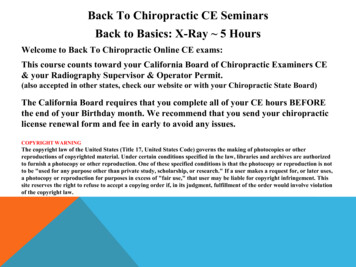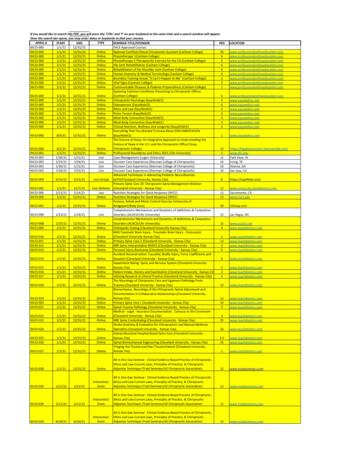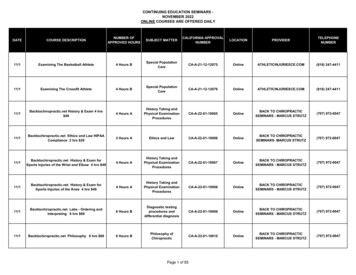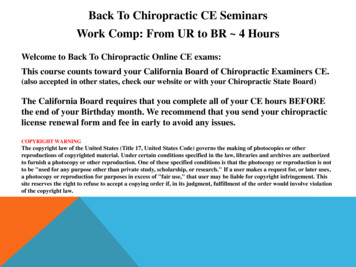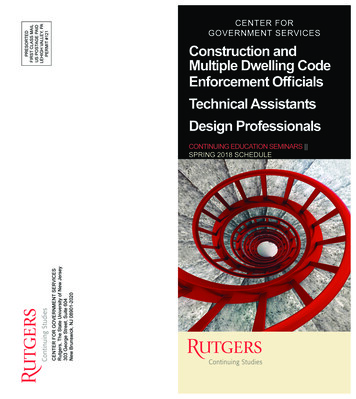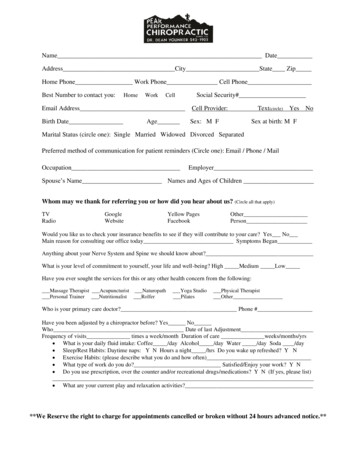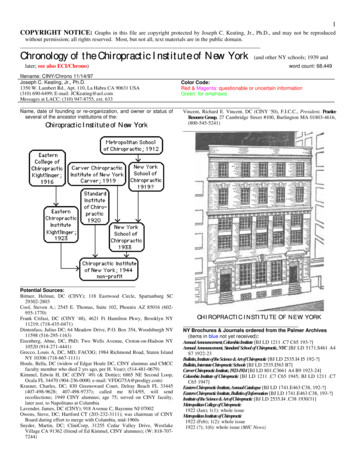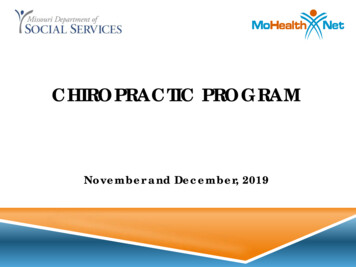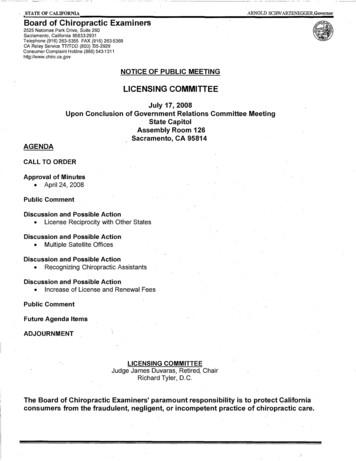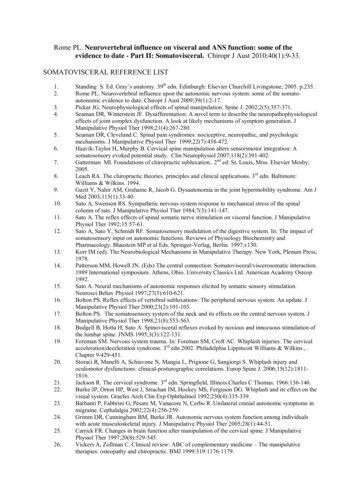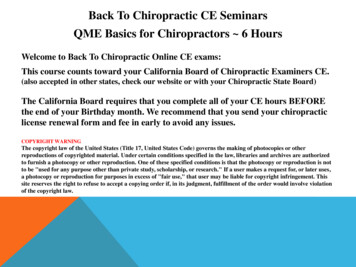
Transcription
Back To Chiropractic CE SeminarsQME Basics for Chiropractors 6 HoursWelcome to Back To Chiropractic Online CE exams:This course counts toward your California Board of Chiropractic Examiners CE.(also accepted in other states, check our website or with your Chiropractic State Board)The California Board requires that you complete all of your CE hours BEFOREthe end of your Birthday month. We recommend that you send your chiropracticlicense renewal form and fee in early to avoid any issues.COPYRIGHT WARNINGThe copyright law of the United States (Title 17, United States Code) governs the making of photocopies or otherreproductions of copyrighted material. Under certain conditions specified in the law, libraries and archives are authorizedto furnish a photocopy or other reproduction. One of these specified conditions is that the photocopy or reproduction is notto be "used for any purpose other than private study, scholarship, or research." If a user makes a request for, or later uses,a photocopy or reproduction for purposes in excess of "fair use," that user may be liable for copyright infringement. Thissite reserves the right to refuse to accept a copying order if, in its judgment, fulfillment of the order would involve violationof the copyright law.
Exam Process: Please read all instructions before starting!1. You must register/pay first. If you haven't, please return to: backtochiropractic.net2. Open a new window or a new internet tab & drag it so it's side-by-side next to this page.3. On the new window or new tab you just opened, go to: backtochiropractic.net website.4. Go directly to the Online section. DON'T register again.5. Click on the Exam for the course you want to take. No passwords needed.6. Follow the Exam instructions.7. Upon passing the exam you’ll be able to immediately download your certificate,and it’ll also be emailed to you. If you don’t pass, you can repeat the exam at no charge.Please retain the certificate for 4 years.If you get audited and lose your records, I’ll have a copy.I’m always a phone call away. 707.972.0047 or email: marcusstrutzdc@gmail.comMarcus Strutz, DCBack To Chiropractic CE Seminars
GLENN CRAFTS, B.S., D.C.Qualified Medical Evaluator 2021 Copyright - ALL RIGHTS RESERVEDDo Not Duplicate or Distribute without written permission
Disclaimer The following course material contains the opinions of the author and does not reflectthe opinions of the Division of Workers’ Compensation, or associated entities. Thiscourse is intended to be used as a reference tool in assisting QMEs, and is not to be reliedon as legal advice.
Purpose of the Q.M.E. Qualified medical evaluators (QMEs) are qualified physicians who are certified by theDivision of Workers' Compensation - Medical Unit to examine injured workers toevaluate disability and write medical-legal reports. These Med-Legal reports are used to determine an injured worker's eligibility for workers'compensation benefits. QMEs include medical doctors, doctors of osteopathy, doctors of chiropractic, dentists,optometrists, podiatrists, psychologists and acupuncturists.
Definitions Q.M.E.: Qualified Medical Evaluator P.Q.M.E.: Panel Qualified Medical Evaluator; selected via a panel list of three QMEsbased on residential zip code. A.M.E.: Agreed Medical Evaluator; Selected by agreement between the defenseattorney/claims administrator & the applicant attorney, and may or may not be a QME. I.D.E.: Industrial Disability Evaluator; previous pre-requisite certification in reportwriting to become a Q.M.E. Consisted of a 44 hour Med-Legal/WC report writingcourse.
Definitions Apportionment: Must be based on Substantial Evidence. A physician shall make an apportionmentdetermination by finding what approximate percentage of the permanent disability was caused bythe direct result of injury arising out of and occurring in the course of employment and whatapproximate percentage of the permanent disability was caused by other factors both before andsubsequent to the industrial injury, including prior industrial injuries. Substantial Evidence: Consists of the following essential elements within the Med-Legal report;1. Opinion must be based on “reasonable medical probability.”2. The report must contain a legally compliant apportionment discussion pursuant to LC 4663.3. A medical report cannot be “predicated on incorrect legal theory.” Proximate Cause: Proximate Cause is the event that causes subsequent related events that result ininjury. Proximate cause is referred to as the “cause and effect” of the industrial injury. Without acause/action, there would not be a resulting injury. Overlap: Overlap refers to similar findings pertaining to the prior permanent disability and thecurrent one. Defendants have the burden of proving overlap between the prior award and the newrating. Duplication: The determination if some or all factors of disability are the same or different. If thedisability is the same, then duplication exists. If the factors of disability are different, thenduplication does not exist. Duplication is relevant in situations where multiple body parts rendersimilar disabilities (i.e. knee & back). The physician needs to explain why and how the disabilities aredifferent. If not, the factors of disability will be found to be duplicative.
Definitions Medical Probability: Reasonable medical probability refers to at least a 51% probability thatsomething is true. Section 4663: Medical Apportionment. The employer should only be responsible for theinjured worker’s disability related to the industrial injury. Section 4664: Legal Apportionment. The employer shall only be liable for the percentage ofpermanent disability directly caused by the injury arising out of and in the course ofemployment. Labor Code 4750: Repealed in 2004. Previously, apportionment could be obtained underLabor Code section 4750 for a pre-existing permanent disability or physical impairment. Labor Code 4750.5: Allowed defendants to obtain apportionment to subsequent non-compensable injuries (i.e. multiple employers).
Definitions California Evidence Code Section 140: "Evidence" means testimony, writings, materialobjects, or other things presented to the senses that are offered to prove the existence ornonexistence of a fact. SB 899: Major workers’ compensation reform in 2004 SB 863: Major workers’ compensation reform in 2013 Cumulative Trauma: CT or Repetitive Stress Injuries (RSI) deal with micro trauma over an extendedduration of time. CT/RSI cases often times require apportionment as the injured worker sustainedthe injury across multiple employers where overlap may have occurred. Permanent Disability vs. Impairment: For DOIs 01/01/2005 use AMA Guides 5th edition forimpairment ratings. For DOIs 01/01/2005 use PDRS (Permanent Disability Rating Schedule).
QME DWC FAQs Q. What is a QME? A. A qualified medical evaluator (QME) is a physician who evaluates you when there arequestions about what benefits you should receive. A physician must meet educationaland licensing requirements to qualify as a QME. They must also pass a test andparticipate in ongoing education on the workers' compensation evaluation process. If youhave an attorney, you and your claims administrator might agree on a doctor to resolvemedical disputes. This doctor is called an agreed medical evaluator (AME). An AME or apanel QME will be used to resolve medical disputes in your workers' compensation case.
QME DWC FAQs Q. What is the difference between an AME and a QME? A. If you have an attorney, your attorney and the claims administrator may agree on adoctor without going through the state system used to pick a QME. The doctor yourattorney and the claims administrator agree on is called an agreed medical evaluator(AME). A QME is picked from a list of state-certified doctors issued by the DWC MedicalUnit. QME lists are generated randomly. An AME can only be used if you are representedby an attorney. Once you see an AME you are not entitled to see a QME. An AME may beused regardless of the year of injury. An AME physician may be a QME, but does not haveto be one. Q. What is a panel QME? A. In this context, the word panel means a list. A panel QME is a randomly generated listof three QME physicians issued to you when there is a question about whether or notyour injury is work related, or if there is a medical dispute that hasn't been resolved bythe treating physician's report. Whoever fills out the form to request the panel QMEchooses the specialty of the doctors on the panel.
QME DWC FAQs Q. I have two different problems from the same injury (for instance, a psychiatricand an orthopedic problem). May I request two panels, one psychiatric and oneorthopedic? A. The basic rule is that you get one. The claims administrator is only required to pay forone QME evaluation. The selected QME can get a consultation from another physician ifthere is a need for input from more than one medical specialty. However, there are some circumstances where a workers' compensation administrativelaw judge, the Division of Workers' Compensation's executive medical director or a stateinformation & assistance officer may request an additional panel. In those cases, a panelwill be provided.(Title 8, California Code of Regulations, section 32 (c), Labor Code sections 5703.5(a),5703.5(b), 4063.3(i))
QME DWC FAQs Q. Can I get a new panel because the physicians on the panel are too far away? A. No. The Medical Unit cannot replace physicians based on distance from your addressand cannot simply choose the physicians closest to you. By law, the QME panel processmust be done randomly according to ZIP code. The claims administrator will pay yourtransportation costs to see the QME. Q. The QMEs on the panel you issued are close to my home. However, can yougive me a panel closer to work? A. The law requires the Medical Unit to issue panels close to your residence. However, theDWC Medical Unit can issue a panel of QMEs using the ZIP code of your workplace if theclaims administrator agrees to this request.(Title 8, California Code of Regulations, section 31.5 (b) (2, Labor Code section 139.2 (h))
QME DWC FAQs Q. I was issued a panel of orthopedists at the claims administrator's request.However, I want to see a chiropractor. Will you issue a new panel? A. No. You had the first chance to send in the request form and to select the specialty ofthe QME. If you (the injured worker) failed to make the request within the 10-daydeadline, the claims administrator has the right to select the specialty of the panel.
QME DWC FAQs Q. My QME evaluation was yesterday. How long does the doctor have to issue the report? A. The QME has 30 calendar days from the date of the commencement of the exam to issue thereport. There are three reasons a physician may request an extension:1.The physician requested you have medical tests and is awaiting results2.The physician requested a consultation and is awaiting the consultant's report3.The physician has a "good cause" for an extension. A good cause is a medical emergency of theevaluator or the evaluator's family, death in evaluator's family, natural disaster or other communitycatastrophes that interrupt the operation of the evaluator's office. The computer breaking down or astaff member quitting is not considered good cause. Extensions for good cause may not exceed 15days from the date the report is required to be served. The physician may not request an extension because the claims administrator failed to provide yourmedical records or past medical tests. If the report is going to be late, the physician must file a timeframe extension request with the DWC Medical Unit and send a copy to the claims administrator andto you. This must be filed five days before the report is due. (Title 8, California Code of Regulations,section 38)
QME DWC FAQs Q. I need another evaluation. Should the original QME do it? What if that physician is nolonger performing QME evaluations? A. The second evaluation should be done by the same QME. The exceptions to this rule are: The physician is no longer availableThe physician became the treating physician after performing the QME evaluationA workers' compensation administrative law judge decides you should have a new evaluation with adifferent QME. If any exception applies, you may begin the QME request process again and you will receive a newpanel.(Labor Code sections 4062.3(j); 4067)
QME DWC FAQs Q. Why are my medical and non-medical records sent to the QME? A. These records give the QME a history of your injury. The physician's records indicate the diagnosis and treatmentreceived to date. Test results, such as MRIs, are forwarded so that the QME will not have to duplicate the tests. Medicalrecords about treatment prior to the injury are often sent to help determine how much of the permanent disability isdue to this injury and how much may be due to a prior injury or accident. Non-medical records, such as personnelrecords or films, are sent to provide information regarding the injury to the QME physician. Non-medical records may include personnel records or films. Once you make the QME appointment, the physician has five days to send the QME appointmentnotification form to the claims administrator advising them of the appointment. The claimsadministrator is required to send you a copy of everything they plan to send to the QMEphysician 20 days prior to sending the records to the QME. You are also required to send any information (letters from friends, personal records) you are planningto send to the QME to the claims administrator 20 days before you send it to the QME. Both you and the claims administrator (or your respective attorneys) have 10 days to object to any nonmedical records being sent to the QME. There is no form for this objection. Whoever is objectingsimply writes a letter to the other party. If either you or the claims administrator does not follow the 20-day rule, the wronged party has theright to cancel the evaluation.(Title 8, California Code of Regulations, section 35, Labor Code section 4062.3 (b))
QME DWC FAQs Q. The QME evaluation is next week, but I have not received the medical recordsand neither has the QME. What should be done? A. There are two options:1. You may cancel the appointment, call the claims administrator or treating doctor toobtain the records, and then reschedule the appointment2. You may keep the appointment and have the claims administrator send the records toyou and then to the QME after the evaluation. Some QMEs don't want to do anevaluation without the records, so check with the QME's office to see if the appointmentshould be rescheduled.
How to Become & be Selected as a QMELabor Code Section 4061 Labor Code Section 4061: Disputes over permanent disability (PD) and any need forfuture medical care. Labor Code section 4061 requires there be an objection to themedical determination made by the primary treating physician (PTP). Unrepresented Cases: If either the employee or employer objects to a medical determination made by thetreating physician concerning the existence or extent of permanent impairment andlimitations or the need for future medical care, and if the employee is not represented byan attorney, the employer shall immediately provide the employee with a formprescribed by the medical director with which to request assignment of a panel of threequalified medical evaluators.
How to Become & be Selected as a QMELabor Code Section 4061 Labor Code Section 4061: Disputes over permanent disability (PD) and any need forfuture medical care. Labor Code section 4061 requires there be an objection to themedical determination made by the primary treating physician (PTP). Represented Cases: If either the employee or employer objects to a medical determination made by thetreating physician concerning the existence or extent of permanent impairment andlimitations or the need for future medical care, and the employee is represented by anattorney, a medical evaluation to determine permanent disability shall be obtained asprovided in Section 4062.2.
Labor Code Section 4610Utilization Review The UR process is governed by Labor Code section 4610 and regulations written bythe CA Division of Workers' Compensation (DWC), which lay out timeframes and otherrules for conducting UR. The rules, contained in Title 8, California Code of Regulations,sections 9792.6 et seq, also require UR plans to be filed with the DWC administrativedirector. Additionally, the DWC has promulgated regulations that provide for penalties to applywhen claims administrators and UR companies don't follow UR rules. The UR penalty regulations, found in Title 8, California Code of Regulations, sections9792.11 - 9792.15, provide an enforcement mechanism to ensure utilization reviewsare conducted in compliance with UR regulations.
Labor Code 4604.5 (a) The recommended guidelines set forth in the medical treatmentutilization schedule adopted by the administrative director pursuantto Section 5307.27 shall be presumptively correct on the issue ofextent and scope of medical treatment. The presumption is rebuttable and may be controverted by apreponderance of the scientific medical evidence establishingthat a variance from the guidelines reasonably is required to cure orrelieve the injured worker from the effects of his or her injury. Thepresumption created is one affecting the burden of proof. (b) The recommended guidelines set forth in the schedule adoptedpursuant to subdivision (a) shall reflect practices that are evidenceand scientifically based, nationally recognized, and peerreviewed. The guidelines shall be designed to assist providers byoffering an analytical framework for the evaluation and treatment ofinjured workers, and shall constitute care in accordance with Section4600 for all injured workers diagnosed with industrial conditions.
Labor Code 4604.5 (c) (1) Notwithstanding the medical treatment utilization schedule, for injuriesoccurring on and after January 1, 2004, an employee shall be entitled to no morethan 24 chiropractic, 24 occupational therapy, and 24 physical therapy visitsper industrial injury. (2) (A) Paragraph (1) shall not apply when an employerauthorizes, in writing, additional visits to a health care practitioner forphysical medicine services. Payment or authorization for treatment beyond the limits set forth in paragraph (1)shall not be deemed a waiver of the limits set forth by paragraph (1) with respect tofuture requests for authorization. (B) The Legislature finds and declares that theamendments made to subparagraph (A) by the act adding this subparagraph aredeclaratory of existing law. (3) Paragraph (1) shall not apply to visits for postsurgicalphysical medicine and postsurgical rehabilitation services provided in compliancewith a postsurgical treatment utilization schedule established by the administrativedirector pursuant to Section 5307.27. (d) For all injuries not covered by the official utilization schedule adoptedpursuant to Section 5307.27, authorized treatment shall be in accordancewith other evidence-based medical treatment guidelines that are recognizedgenerally by the national medical community and scientifically based.
Title 8, California Code of Regulations, section 10606:Physicians' Reports as Evidence Chapter 4.5. Division of Workers' CompensationSubchapter 2. Workers' Compensation Appeals Board--Rules and Practice ProcedureArticle 9. Evidence and Reports (a) The Workers' Compensation Appeals Board favors the production of medical evidence in the form of written reports. (b) Medical reports should include where applicable:(1) the date of the examination;(2) the history of the injury;(3) the patient's complaints;(4) a listing of all information received in preparation of the report or relied upon for the formulation of the physician's opinion;(5) the patient's medical history, including injuries and conditions, and residuals thereof, if any;(6) findings on examination;(7) a diagnosis;(8) opinion as to the nature, extent, and duration of disability and work limitations, if any;(9) cause of the disability;(10) treatment indicated, including past, continuing, and future medical care;(11) opinion as to whether or not permanent disability has resulted from the injury and whether or not it is stationary. Ifstationary, a description of the disability with a complete evaluation;(12) apportionment of disability, if any;(13) a determination of the percent of the total causation resulting from actual events of employment, if the injury is alleged tobe a psychiatric injury;(14) the reasons for the opinion; and,(15 ) the signature of the physician.
Pros & Cons of being a Chiropractic QME Record Review: LC 4628 requires review and provide medical record summary of allrelevant records, and composing & drafting any conclusions. Research: Extra clinical research may be warranted. For example, if a condition is notclearly addressed, the evaluator may seek other sources that are considered evidencebased medicine/peer reviewed literature. Report Writing: Address all issues at hand and correlate to physical examinationfindings, record review and patient history. Preparation for Examination: Prepare beforehand which physical examinationprocedures are required based on the body part(s) involved and associated with anyimpairment ratings that may apply. Preparation for Depositions: Review your prior Med-Legal report, which shouldinclude all of the record summaries and most current issues at hand. Reviewing prior tothe deposition will help recall specific issues that pertain to the injured worker inquestion.
Pros & Cons of being a Chiropractic QME Follow-Up process on referrals: The QME should make all recommendations forfurther care such as but not limited to; diagnostics, labs, consults, etc. Applicant Attorneys: Legal representation for the injured worker. Defense Attorneys: Legal counsel for the employer/claims administrator. Interpreters: Required to translate during the Med-Legal examination. The claimsadministrator is responsible for paying for the interpretative services. Title 8. Section 34: (c) The QME shall include within the notification whether a CertifiedInterpreter, as defined by Labor Code Section 5811 and subject to the provisions of section9795.3 of Title 8 of the California Code of Regulations, is required and specify thelanguage. The interpreter shall be arranged by the party who is to pay the cost asprovided for in Section 5811 of the Labor Code.
QME Referrals – Section 32 Q. Can a QME make referrals without first obtaining authorization from theemployer/claims administrator? Section 32 of the QME Regulations has changed since 2009 and QMEs are prohibitedfrom making referrals for the purpose of diagnostics and/or consultations without firstobtaining prior authorization. A Request For Authorization (RFA) should be made usingthe DWC form RFA. NOTE: The QME has never been granted permission to refer an injured worker out fortreatment. Any further treatment should be outlined in your QME report, which explains indetail the need for such care. For example, the injured worker is not yet deemed permanentand stationary because of lack of appropriate treatment (i.e. surgery, medications, physicalmedicine, etc.), which may also include diagnostic studies. The QME is prohibited from referring the injured worker out for the purpose of obtaining thedisability/impairment rating, which is the QME's responsibility to determine unless outsidetheir scope of practice.
QME Referrals – Section 32 If the QME is given authorization to make a referral for treatment, diagnostics and/orconsultations, it is their responsibility to follow-up and arrange the referral. (d) Whenever an Agreed Panel QME or a QME determines that a consultation isnecessary pursuant to this section and the physician selected for the consultation is notselected by the parties from a QME panel issued by the Medical Director, the referringQME must arrange the consultation appointment and advise the injured employee andthe claims administrator, or if none the employer, and each party’s attorney if any, inwriting of the appointment date, time and place by use of QME Form 110 (QMEAppointment Notification Form)(See, 8 Cal. Code Regs. § 110). The QME must include and annotate the results within their subsequent supplementalreport within 15 days of receipt of the results and copy all stakeholders.
How to Become a QME Q. How do I become a QME? How do I register for the test? A. To become a QME, you must meet the requirements that are listed in Labor Codesection 139.2. If you meet these requirements, you should submit a completed applicationform to the Division of Workers’ Compensation Medical Unit. You also must submit atest registration form. Prior to becoming a QME you have to pass the QME competencyexam. Tests are scheduled twice a year in April and Oct. Upon passing the test andpaying the QME annual fee, you will be a certified QME. (Labor Code § 139.2(b) (n), 8CCR § 10). Prior to appointment as a QME, a physician is required to take a 12-hourcourse about writing medical legal reports. (8 CCR § 11.5) Q. What is the deadline for submitting my application and registration form? A. A properly completed application for appointment and an exam registration formmust be received, or postmarked, 45 calendar days prior to the date of the exam. (8CCR § 11(f)(4))
How to Become a QME Q. Is there a fee to take the QME exam? A. Yes. There is a 125 fee to take or retake the exam. (8 CCR § 11 (f) (2)) Q. What is the annual fee to be a QME? A. The annual fee is 250 if you performed 25 or more comprehensive medical-legal evaluations in the year prior to assessment of the fee.If you performed 11-24 examinations, the annual fee is 125.If you performed 0-10, the fee is 110.This fee is for one office location.If you wish to have additional locations, the fee is 100 for each additional location.(Labor Code § 139.2 (n), 8 CCR § 17)
How to Become a QME https://www.dir.ca.gov/dwc/medicalunit/QME page.html
PDRS (Permanent Disability Rating Schedule) https://www.dir.ca.gov/dwc/medicalunit/QME page.html
PDRS (Permanent Disability Rating Schedule) https://www.dir.ca.gov/dwc/medicalunit/QME page.html
PDRS (Permanent Disability Rating Schedule) https://www.dir.ca.gov/dwc/medicalunit/QME page.html
Intensity vs. Frequencyof Pain It is important to understand and be able to properly describe frequency and intensity ofpain within the workers’ compensation system. INTENSITY OF PAIN/SYMPTOMS: SEVERE Severe pain would preclude the activity precipitating the pain.MODERATEModerate pain can be tolerated, but would cause a marked handicapin the performance of the activity precipitating the pain.SLIGHTSlight pain can be tolerated, but would cause some handicap in theperformance of the activity precipitating the pain.MINIMALMinimal (same as mild) pain would constitute an annoyance, butwould cause no handicap in the performance of the particular activity.(Minimal pain is a non-ratable permanent disability)
Intensity vs. Frequencyof Pain FREQUENCY OF PAIN/SYMPTOMS: CONSTANT FREQUENT INTERMITTENT OCCASIONALOccurring approximately 75-100% of the timeOccurring approximately 50-75% of the timeOccurring approximately 25-50% of the timeOccurring approximately 0-25% of the time
QME CE Q. How many years is my QME status valid? A. QMEs who initially applied prior to July 17, 1993 were approved for a four-year term.QMEs who were approved on or after July 17, 1993, were approved for a two-year term.Once a QMEs initial term expires, he/she will be reappointed every two years. A QMEmust pay an annual fee in order to maintain his/her status and show proof of havingattended 12 hours of combined education in 24 months. . For initial reappointment,the Medical Unit uses the QME exam passed as 6 hours of continuing education. TheQME is only required to receive 6 hours of continuing education, in order to fulfill the 12hour requirement.
AMA Guidelines ROM vs DRE - Spine Example: DDX: Lumbar Disc Protrusion (L3-4 & L5-S1) (MRI Verified) & Intervertebral Disc Degeneration L3-4 (MRI Verified) Range of Motion (ROM) method to be used with lumbar spine. DRE not to be used for lumbar spine rating when multiple levels are identifiedobjectively through MRI and clinical findings on exam. Table 15-8; Page 407; (Lumbar Flexion/Extension) Chapter 15 Table 15-9; Page 409; (Lumbar Lateral Flexion) Chapter 15Lumbar SpineFlexionExtension(L) Lateral Flexion(R) Lateral FlexionNormal(Degrees )60252525Exam20, 25, 2010, 10, 1212, 12, 1515, 15, 15Exam(Mean)23111415Maximum Angle(WPI%)4%5%2%2%
AMA Guidelines ROM vs DRE - Spine Example: Range of Motion Method as used for the lumbar spine does require combining the 1.) Diagnosis-Based Impairment (table 15-7) 2.) Range of Motion Impairment and 3.) any Impairments due to Neurologic Deficits as described on pages 402-403 of theAMA Guides. 1) Figure 15-10; Page 410; (Lumbar Range of Motion (ROM)* Chapter 15 TOTAL Lumbar ROM Impairment 13% 2) Diagnosis from table 15-7; Page 404; II. Part C. (5 2%) 7% 3) Spinal nerve deficit from table 15-15 & 15-16 & 15-18 1%
AMA Guidelines ROM vs DRE - Spine Example: Sensory Deficit was determined using Table 15-15 in conjunction with Table 15-18 for“Maximum % Loss of Function Due to Sensory Deficit of Pain”. Using Table 15-15, a Grade 4 was selected with a 25% Sensory Deficit pertaining to thelower extremities. L5 was chosen from Table 15-18 and correlates with a Maximum % Loss of Function dueto Sensory Deficit or Pain of 5%. The AMA Guides states to multiply the severity of the sensory deficit (25%)/(Table 15-15)by the maximum im
Welcome to Back To Chiropractic Online CE exams: This course counts toward your California Board of Chiropractic Examiners CE. (also accepted in other states, check our website or with your Chiropractic State Board) The California Board requires that you complete all of your CE hours BEFORE the end of your Birthday month.

